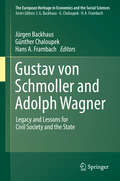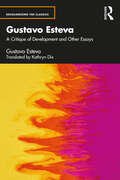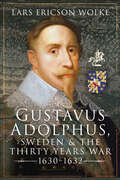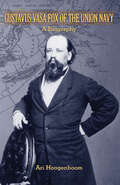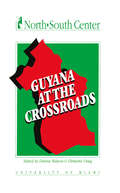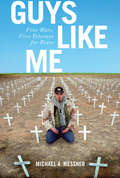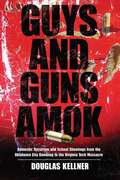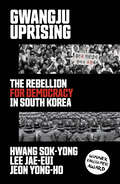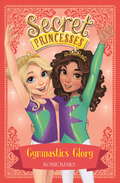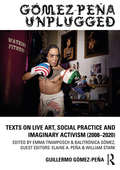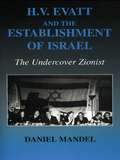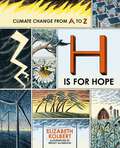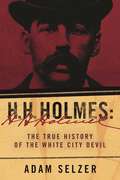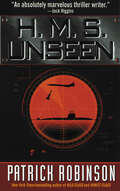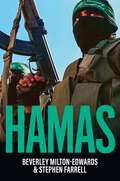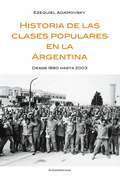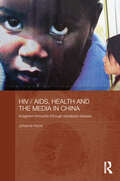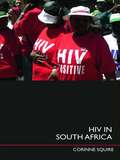- Table View
- List View
Gustav Stresemann: The Crossover Artist (Studies in German History #23)
by Karl Heinrich PohlAs a foreign minister and chancellor of Weimar Germany, Gustav Stresemann is a familiar figure for students of German history – one who, for many, embodied the best qualities of German interwar liberalism. However, a more nuanced and ambivalent picture emerges in this award-winning biography, which draws on extensive research and new archival material to enrich our understanding of Stresmann’s public image and political career. It memorably explores the personality of a brilliant but flawed politician who endured class anxiety and social marginalization, and who died on the eve of Germany’s descent into economic and political upheaval.
Gustav von Schmoller and Adolph Wagner
by Jürgen Backhaus Günther Chaloupek Hans A. FrambachThis book discusses the work of German economists Gustav von Schmoller and Adolph Wagner, its influence on the tradition of German and Austrian economic and social thought, and its implications for the discipline today. Schmoller and Wagner integrated philosophical, historical, sociological and political approaches into the science of economics, focusing specifically on economic development. Schmoller, who is considered the head of the second generation of the German Historical School, argued that general propositions of economic theory had to be based on historical-empirical studies. In contrast, Wagner was a systematologist who preferred to start his investigations into economic problems from abstract principles. Schmoller and Wagner share, however, a common focus on institutions and the role of the state; Wagner favored state policy initiatives, while Schmoller was concerned with the risks of state policy failure. One hundred years after their deaths, the contributions to this book look into their approach, trace the influence of their ideas, and explore the relevance of their thought in a global economy. This book will be useful for students and scholars interested in socio-economics, the history of economic thought, economic policy, and political science.
Gustavo Esteva: A Critique of Development and other essays (Decolonizing the Classics)
by Gustavo EstevaIn his reflections on decolonization and post-development, Gustavo Esteva forged a unique synthesis of critical theory and political economy. This book presents more than half a century of "reflection in action" in the form of essays, books, and interventions in national and international forums and newspaper articles—most published here for the very first time. It showcases Esteva’s evolving thought on economic theory, social change, revolutionary subjectivity, transition, development, the challenges of a new era and personal and communal autonomy, all associated with the challenges and advances in the construction of a new society. Through this translation, Esteva’s writings engage with many of the important cultural and political debates of the present day and retain their power both to provoke and move the reader. Readers will see a thinker at work, formulating local, grassroots alternatives as they are emerging in Mexico and Latin America, with a keen sensibility to what happens in other regions of the world. Gustavo Esteva: A Critique of Development and Other Essays offers a lucid insight into the climatic and sociopolitical collapses we face and will be of interest to students and scholars of critical theory, post-colonial and de-colonial studies, and post-development studies.
Gustavus Adolphus, Sweden and the Thirty Years War, 1630–1632
by Lars Ericson WolkeThe little-known story of the Swedish king and military commander who conquered much of Germany in the early seventeenth century. As one of the foremost military commanders of the early seventeenth century, Gustavus Adophus, king of Sweden, played a vital role in defending the Protestant cause during the Thirty Years War. In the space of two years—between 1630 and 1632—he turned the course of the war, winning a decisive victory at the Battle of Breitenfeld and conquering large parts of Germany. Yet remarkably little has been written about him in English, and no full account of his extraordinary career has been published in recent times. That is why this perceptive and scholarly study is of such value. The book sets Gustavus in the context of Swedish and European dynastic politics and religious conflict in the early seventeenth century, and describes in detail Swedish military organization and Gustavus&’s reforms. His intervention in the Thirty Years War is covered in graphic detail—the decision to intervene, his alliance with France, his campaigns across the breadth of Germany, and his generalship at the two major battles he fought there. His exceptional skill as a battlefield commander transformed the fortunes of the Protestant side in the conflict, and he had established himself as a major European figure before his death on the battlefield. Lars Ericson Wolke, one of the leading experts on the military history of the Baltic and the Thirty Years War, offers a fascinating insight into Gustavus the man and the soldier.
Gustavus Vasa Fox of the Union Navy: A Biography
by Ari HoogenboomThis magisterial biography recounts the life and career of one of the U.S. Navy’s most influential officers, Gustavus Vasa Fox. Ari Hoogenboom's examination of Fox's incredible life and distinguished career creates a vivid portrait of the man most responsible for the U.S. Navy's stellar performance in the Civil War. Fox’s naval service began in 1838 when he went to sea as a midshipman. He sailed in the Mediterranean, off the coast of Africa, in the Gulf of Mexico, and with the East India Squadron in the Pacific. By participating in the Coast Survey and by navigating the lower Mississippi River in the 1850s, as captain of a steamer that ran from New York to Havana to New Orleans and back, Fox gained valuable experience that would serve him well in the Civil War.During the war, Fox was instrumental in mounting the blockade of the southern coast, from the Chesapeake Bay to the Rio Grande. After the battle between the Monitor and the Virginia, Fox championed ironclad technology despite having to contend with an officer corps wedded to wooden ships. In planning and coordinating expeditions, Fox deserves much of the credit for the navy's successes at Hatteras, Port Royal, New Orleans, Mobile Bay, and Fort Fisher.Initially neither proslavery nor antislavery, Fox was passionately committed to the preservation of the Union and, as black sailors made a crucial contribution toward that end, became an advocate of freedom and voting rights for African Americans. A skilled administrator who understood both the demands of politicians and the needs of line officers, he was able to communicate effectively with each group. Fox developed a close and collegial working relationship with Abraham Lincoln and was related by marriage to the postmaster general. Along with officers like Quartermaster General Montgomery Meigs and coordinator of military railroads Herman Haupt, Fox played a critical but underappreciated role in the Union victory.
Guyana at the Crossroads
by Dennis Watson Christine CraigThis is a collection of discussions and presentations collected from the seminar, Guyana at the Crossroads, held on November 1, 1991, was sponsored and organized by the Caribbean Resources Development Foundation (CARDEV) in association with the North- South Center, University of Miami, and Florida International University. The main objective of the seminar was to provide an open, nonpartisan forum for discussion of ideas, policies, and directions of change in political and economic arenas. To this end, CARDEV invited government spokesmen and leaders of the major opposition parties to participate in presentations and panel discussions.
Guys Like Me: Five Wars, Five Veterans for Peace
by Michael A. MessnerOver the last few decades, as the United States has become embroiled in foreign war after foreign war, some of the most vocal activists for peace have been veterans. These veterans for peace come from all different races, classes, regions, and generations. What common motivations unite them and fuel their activism? Guys Like Me introduces us to five ordinary men who have done extraordinary work as peace activists: World War II veteran Ernie Sanchez, Korean War veteran Woody Powell, Vietnam veteran Gregory Ross, Gulf War veteran Daniel Craig, and Operation Iraqi Freedom veteran Jonathan Hutto. Acclaimed sociologist Michael Messner offers rich profiles of each man, recounting what led him to join the armed forces, what he experienced when fighting overseas, and the guilt and trauma he experienced upon returning home. He reveals how the pain and horror of the battlefront motivated these onetime warriors to reconcile with former enemies, get involved as political activists, and help younger generations of soldiers. Guys Like Me is an inspiring multigenerational saga of men who were physically or psychically wounded by war, but are committed to healing themselves and others, forging a path to justice, and replacing endless war with lasting peace
Guys and Guns Amok: Domestic Terrorism and School Shootings from the Oklahoma City Bombing to the Virginia Tech Massacre
by Douglas KellnerFrom the recent shootings at Virginia Tech University to the tragedies at Columbine and Oklahoma City, certain common traits can be traced through all of these events. In Guys and Guns Amok, media and cultural critic Douglas Kellner provides a fascinating diagnostic reading of these acts of domestic terrorism. Skillfully connecting each case with the current environment for male socialization and the search for identity in an American culture obsessed with guns and militarism, Kellner's work is a sobering reflection on these tragedies and the pervasive power of media and popular culture as well as a wake-up call for the future.
Gwache Arth (The Lost Meaning)
by Niranjan TasnimGwache Arth (The Lost Meaning) written in 1993 is an odyssey in search of the lost meaning of life during the turbulent period of nineteen eighties in the Punjab.
Gwangju Uprising: The Rebellion for Democracy in South Korea
by Hwang Sok-yong Lee Jae-Eui Jeon Yong-HoThe essential account of the South Korean 1980 pro-democracy rebellionOn May 18, 1980, student activists gathered in the South Korean city of Gwangju to protest the coup d&’état and the martial law government of General Chun Doo-hwan. The security forces responded with unmitigated violence. Over the next ten days hundreds of students, activists, and citizens were arrested, tortured, and murdered. The events of the uprising shaped over a decade of resistance to the repressive South Korean regime and paved the way for the country&’s democratization. This fresh translation by Slin Jung of a text compiled from eyewitness testimonies presents a gripping and comprehensive account of both the events of the uprising and the political situation that preceded and followed the violence of that period. Included is a preface by acclaimed Korean novelist Hwang Sok-yong. Gwangju Uprising is a vital resource for those interested in East Asian contemporary history and the global struggle for democracy.
Gwynne's Kings and Queens: The Indispensable History of England and Her Monarchs
by Nevile GwynneDo you know your Kings and Queens of England by heart? Can you tell your Ethelred from your Ethelbert? Your Marcia from your Matilda? Well, passionate educator Mr Gwynne is back – and this time he is taking on the entirety of British history – so you will never be in the dark again. Within the pages of this little gem – bursting with our small island’s rich past – he teaches us the history of England through her remarkable monarchs. It is Mr Gwynne’s belief that a certain amount of what you might read in other history books may well be wrong. It is his aim to show you why.Concise, thorough and utterly fascinating, this is the perfect book to be enjoyed by young and old, to be read at a time when, for many, harking back to our rich past seems much more preferable than living in the dreary present.And when it comes to the benefits of education, Mr Gwynne is never wrong!
Gymnastics Glory: Book 11 (Secret Princesses #11)
by Rosie BanksA gorgeous new series about magical princesses and best friends. Best friends Charlotte and Mia can't bear it when Charlotte's family moves far away. But when they become trainee Secret Princesses they begin an amazing adventure together - and they can see each other whenever they like!Mean Princess Poison has cast a spell on four of the Secret Princesses and made them forget all about their magic. Can the girls remind Princess Kiko about Wishing Star Palace and make a wish come true for a girl just like them?Plus collect the tokens for a exclusive Best Friends necklace designed by Monsoon!**while stocks last
Gypsy and Traveller Ethnicity: The Social Generation of an Ethnic Phenomenon
by Brian A BeltonThe book explores the notion of Gypsy and Traveller ethnicity and provides a critique of the conceptual basis of racial and ethnic categorisation. An analysis of the post-war housing situation is given in order to illustrate a connection between social and economic conditions, legislation affecting gypsies and travellers and the visibility and general consciousness of the gypsy and traveller population. The originality of the book lies in its argument that the position of gypsies and travellers largely arises out of social conditions and interaction rather than political, biological or ideological determinants. It puts forward the notion of an ethnic narrative of traveller identity and illustrates how variations of this have been defensively deployed by some travellers and elaborated on by theorists. Belton focuses on the social generation of travellers as a cultural, ethnic and racial categorization, offering a rational explanation of the development of an itinerant population that is less ambiguous and more informative in terms of the social nature of the gypsy and traveller position than interpretations based on 'blood', 'breed', 'stock', ethnicity or race that dominate the literature.
Gómez-Peña Unplugged: Texts on Live Art, Social Practice and Imaginary Activism (2008–2020)
by Guillermo Gómez-PeñaGómez-Peña Unplugged is an anthology of recent and rewritten classic writings from Guillermo Gómez-Peña, a figure who stands alone as unique and ground-breaking in the history of performance art and as the artistic director of transdisciplinary performance troupe La Pocha Nostra. Throughout this collection, Gómez-Peña tackles literature, theory, pedagogy, activism and live art in an eclectic mix that demonstrates how the process of writing is simultaneously a performative exercise in embodied language. The writing stands as a call for action, utilizing what Gómez-Peña terms “imaginary activism” and “radical citizenship”; it invites the reader to embrace a borderless, polygendered, crossgenerational and race-literate ethos. This timely anthology comes straight from the heart of a troubled Trump-era United States and a crime cartel–ridden Mexico. Artists and writers are prompted to engage in radical performance pedagogy within the civic realm and to think of themselves as public intellectuals and “artivists” participating in the great debates of our times. By encouraging emerging artists and writers to wildly imagine their practice beyond the normative art world and academia, this book is a fundamental read for scholars and students of performance art, political theatre, cultural studies, literature, poetry, activism and race and gender politics. Performance Art, Live or Time-Based Art, Cultural Studies, Experimental Poetry, Multiculturalism, Social Practice, Chicano/Latino/Border Art & Literature, Relational Aesthetics, Public Art, Artivism, Activism, Psychomagic Ritual, Literary Studies, Anthropology, Sociology, Ethnic & Gender Studies, Queer & Women Studies, Post-Colonial Theory, Techno-Art, Cyborgian Studies, Exoticized & Fetishized Identities, Deconstruction Stereotypes & Binaries, Anti-Essentialism, Anti-Nationalism, Radical Citizenship, Anti-Racism, Race & Gender Literacy
H V Evatt and the Establishment of Israel: The Undercover Zionist (Israeli History, Politics and Society #Vol. 36)
by Daniel MandelThe Minister for External Affairs, and the dominant force in the formation of Australian foreign policy for a crucial decade in the battle over Palestine (1941-1949), Herbert Vere Evatt played a central role in the Australian political response to Zionism and the conflict in Palestine. This book, which uses a variety of primary sources from Australia, Israel, the United Kingdom and the United States, provides a valuable study of Evatt the Zionist, as well as illuminating a fascinating political figure. This valuable book charts the debate in Australia over the creation of a Jewish state as well as providing a genuinely entertaining study of Evatt himself.
H is for Hope: Climate Change from A to Z
by Elizabeth KolbertClimate change resists narrative – and yet we must see clearly what&’s happening in our world. Millions of lives are at stake, and upwards of a million species. We must act. 'To be a well-informed citizen of Planet Earth, you need to read Elizabeth Kolbert.' ROLLING STONE In H is for Hope, Elizabeth Kolbert investigates the history, and future, of climate change – from A, for Svante Arrhenius, who created the world&’s first climate model in 1894, to Z, for Net Zero. Along the way she looks at Greta Thunberg&’s &‘blah blah blah&’ speech, flies an all-electric plane, experiments with the effects of extreme temperatures on the human body, and struggles with the deep uncertainty of the future. Complemented by Wesley Allsbrook&’s gorgeous, colour illustrations, H Is for Hope offers an inspiring, worrying and, above all, hopeful vision for how we can still save our planet.
H. H. Holmes: The True History of the White City Devil
by Adam SelzerAmerica's first and most notorious serial killer and his diabolical killing spree during the 1893 World's Fair in Chicago, now updated with a new afterword discussing Holmes' exhumation on American Ripper.H. H. Holmes: The True History of the White City Devil is the first truly comprehensive book examining the life and career of a murderer who has become one of America’s great supervillains. It reveals not only the true story but how the legend evolved, taking advantage of hundreds of primary sources that have never been examined before, including legal documents, letters, articles, and records that have been buried in archives for more than a century. Though Holmes has become just as famous now as he was in 1895, a deep analysis of contemporary materials makes very clear how much of the story as we know came from reporters who were nowhere near the action, a dangerously unqualified new police chief, and, not least, lies invented by Holmes himself. Selzer has unearthed tons of stunning new data about Holmes, weaving together turn-of-the-century America, the killer’s background, and the wild cast of characters who circulated in and about the famous “castle” building. This book will be the first truly accurate account of what really happened in Holmes’s castle of horror, and now includes an afterword detailing the author's participation in Holmes' exhumation on the TV series, American Ripper. Exhaustively researched and painstakingly brought to life, H. H. Holmes will be an invaluable companion to the upcoming Martin Scorsese and Leonardo DiCaprio movie about Holmes’s murder spree based on Erik Larson’s The Devil in the White City.
H. H. Holmes: The True History of the White City Devil
by Adam SelzerShares with readers America’s first and most infamous serial killer and his diabolical killing spree during the 1893 World’s Fair in ChicagoThe first comprehensive book following the life and career of H. H. HolmesA fascinating true story about a dark moment in Chicago’s historyH. H. Holmes: The True History of the White City Devil uncovers not only the true story of Holmes but also how the legend evolved. It uses hundreds of primary sources that have never been studied before. This includes letters, articles, legal documents, and records that have been tucked away in archives for more than 100 years. While H. H. Holmes is now as famous as he was in 1895, a thorough analysis of modern materials clarifies how much of the story as we know it came from reports who were far from the action, an incredibly unqualified new police chief, and lies from Holmes himself. This book is a tale of an outlaw. It covers Holmes’s own story with new insights. The author, Adam Selzer, has uncovered stunning new data about Holmes. He combines turn-of-the-century America, the crazy group of characters who were in and around the famous “castle” building, and the killer’s own background. This book is the first fully accurate account of what truly happened in Holmes’s horror castle. H. H. Holmes, with its exhaustive research and careful detail, is an irreplaceable partner to the upcoming Leonardo DiCaprio and Martin Scorsese movie about Holmes’s murder spree based on Erik Larson’s The Devil in the White City.
H.M.S. Unseen (Arnold Morgan #3)
by Patrick RobinsonThe H.M.S. Unseen is one of the most efficient, lethal submarines ever built. But suddenly, on a training mission off the English coast, it vanishes, baffling military intelligence on both sides of the Atlantic, including National Security Adviser Admiral Arnold Morgan. A missing weapon is dangerous enough. But then the unthinkable begins to happen... Planes begin blowing up across the skies.Searching for answers, Morgan is convinced that only one man can be behind all these devastating events: his archenemy, the world's most cunning—yet reportedly dead—terrorist spy. Determined to stop his old nemesis, Morgan must use all his wits to find a madman armed with a powerful sub hidden somewhere in a million square miles of ocean. What Morgan doesn't know, however, is that the fanatical terrorist has a plan of his own, one that will bring these two intense warriors face-to-face—and only one will come out alive in one of the most chilling spy stories of the year.
HAMAS: The Quest for Power
by Beverley Milton-Edwards Stephen FarrellDeclared a terrorist menace yet voted into government in a free election, Hamas then used its Gaza power base to launch cross-border attacks that scorched Israel and transformed the dynamics of the Israeli-Palestinian conflict. How did a small Palestinian offshoot of the Muslim Brotherhood grow to challenge long-established rivals such as the PLO? Who supports Hamas and what is its agenda? How powerful has it become and how strong will it remain? With decades of combined experience researching and reporting from the occupied West Bank and Gaza, Jerusalem, and around the Middle East, Beverley Milton-Edwards and Stephen Farrell gained unrivalled access to Hamas. Drawing on years of frontline reporting and interviews with members of the group’s founding generation and their successors who now lead it, they trace Hamas’ path to the shocking attacks of 07 October 2023 and their devastating aftermath. Its critics believe Hamas must be ousted to reach a solution to the Middle East conflict. Hamas’s supporters believe it is the solution. Nobody now believes it can be ignored. Based on their landmark 2010 study which has been thoroughly revised and updated, this book brings the story of Hamas up to the present and will be essential reading for anyone who wants to understand the Middle East today.
HISTORIA DE LAS CLASES POPULARES 2(EBOOK
by Ezequiel AdamovskyLa Argentina es incomprensible sin tomar en cuenta el desempeño que han tenido las clases populares en el pasado y el que aún tienen en el presente. Este libro cuenta la evolución del país desde los tiempos de la organización nacional hasta 2003, poniendo la mirada en los diversos aspectos del mundo popular, desde la vida cotidiana, la cultura, la religiosidad y el trabajo hasta las identidades, las ideologías, las formas de organización gremial y de acción política. No se trata sólo de una historia de los trabajadores, sino de la totalidad múltiple de los grupos que componen las clases populares en todo el territorio. Peones, obreros y empleados, campesinos y pequeños productores de cada región; inmigrantes europeos, pero también de países vecinos; criollos, afroargentinos, indígenas, tanto varones como mujeres, son los protagonistas de esta historia. Se da cuenta aquí del aporte que su presencia significó en la formación de la Argentina como país y se indaga, al mismo tiempo, sobre su lugar en el escenario actual, ofreciendo al lector una síntesis de las mejores investigaciones académicas de los últimos años.
HIV / AIDS, Health and the Media in China: Imagined Immunity Through Racialized Disease (Media, Culture And Social Change In Asia Ser. #23)
by Johanna HoodHIV/AIDS is an increasingly serious problem in China, with an increasing number of new cases every year. As a result, HIV organizations have boomed, with both state and non-governmental organisations responding to the threat with campaigns to increase public awareness of the disease, utilising the media as the primary tool to reshape citizens’ understandings and views of HIV/AIDS. This book explores how HIV/AIDS is portrayed in China’s media. It argues that, despite increasing education campaigns, media coverage and social and academic openness towards HIV/AIDS, many Chinese of the majority Han ethnic group regard infection as a distant possibility, believing themselves to be immune and infection a problem only for certain non-Han ethnic groups with perceived lower moral standards, in particular black Africans. The book explores how HIV/AIDS is reported, analysing the language used in constructing and encoding the health narrative, its subjects, and ideas about the disease. It demonstrates how China’s media frequently employs negative events to present the most extreme possibilities of poverty, danger, disasters and disease, with black Africa portrayed as an antiquated, distant and socioculturally and politically backward place, uniquely unsuitable for the containment of disease, in contrast with the progressive, scientifically sophisticated and morally upstanding Chinese. It argues that this discourse has had the effect of distancing many Chinese from the perceived possibility of infection, thus compromising the effectiveness of public health campaigns on HIV/AIDs. It suggests that the key to combating the spread of the disease lies in challenging the racialised narratives through which the disease is portrayed in China’s media, rather than simply by aiming to educate greater numbers of people.
HIV and East Africa: Thirty Years in the Shadow of an Epidemic (Routledge Studies in African Development)
by Janet SeeleyBy tracing the shadow of the epidemic over the last 30 years in Uganda and more broadly in the region, HIV and East Africa investigates the impact of the epidemic on people’s lives and livelihoods, placing the epidemic within the context of the social, political and economic changes that have occurred over the last three decades. Whilst it inevitably touches on loss and suffering, the message is also about managing the impact of an epidemic which has had a profound impact on many lives. When one looks for traces in southern Uganda, once thought to be the epicentre of the epidemic, it is hard to see any lasting impact at a community wide level. Delve deeper and there are scars to be found among families and patterns of change which are a direct result of the epidemic The book goes on to explore the effect of improved treatment and care on perceptions of the epidemic and concludes by putting HIV into the context of other disease outbreaks, reflecting on what we can learn from the history of other epidemics as well as the last 30 years of the HIV epidemic.
HIV in South Africa: Talking about the big thing
by Corinne SquireWinner of the Sociology of Health and Illness Book Prize 2008 Of approximately 37 million HIV positive people in the world, 24.7 million live in sub-Saharan Africa and about 5..5 million in South Africa. Despite its relatively powerful economy and infrastructure, South Africa has been dramatically affected by the HIV pandemic. Using narrative analysis of a three year interview study and textual analysis of political materials, HIV in South Africa examines the impact of HIV on people's everyday lives in the country. Examining the relationship between personal accounts of living with HIV and wider medical, political and religious discourses, the book also highlights the significance of class, race and gender on individuals' experiences. These engaging stories of everyday lives provide an accessible way to connect with HIV as a health and development issue. Fascinating, challenging and constructive, this is an important contribution in an area of great social relevance. The ebook is available free of charge to those with addresses on the United Nations Development Programme's Human Development Index of Medium and Low Rankings (see http://hdr.undp.org/hdr2006/pdfs/report/HDR_2006_Tables.pdf), who can apply to the following address: www.ebookstore.tandf.co.uk
HIV/AIDS Communication in South Africa: Are You Human?
by Colin ChasiEven though sub-Saharan Africa is the region most affected by HIV/AIDS in the world, no new theories have been discovered, and questions about life and death are ignored. This book uses certain selected communication practices to offer the foundations of an African theory of communication, applicable to the crisis of HIV/AIDS.

